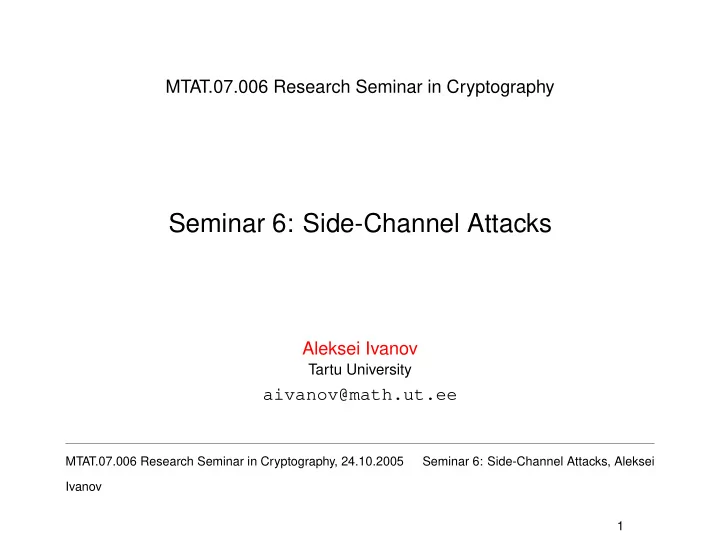

MTAT.07.006 Research Seminar in Cryptography Seminar 6: Side-Channel Attacks Aleksei Ivanov Tartu University aivanov@math.ut.ee MTAT.07.006 Research Seminar in Cryptography, 24.10.2005 Seminar 6: Side-Channel Attacks, Aleksei Ivanov 1
Overview of the Lecture • Types of Information Leakage • Attacks • Countermeasures MTAT.07.006 Research Seminar in Cryptography, 24.10.2005 Seminar 6: Side-Channel Attacks, Aleksei Ivanov 2
Types of information leakage • Execution time leakage • Power consumption leakage • Electromagnetic radiation leakage • Error message leakage • Combining side-channels MTAT.07.006 Research Seminar in Cryptography, 24.10.2005 Seminar 6: Side-Channel Attacks, Aleksei Ivanov 3
Types of attacks • Passive attacks Attacker eavesdrops on some side-channel information, which is analysed afterwords to reveal some secret information • Active attacks Attacker takes active part in the attack: assuming the attacker is able to deviate the device from its normal behaviour, and tries to gain addi- tional information by analysing its reactions MTAT.07.006 Research Seminar in Cryptography, 24.10.2005 Seminar 6: Side-Channel Attacks, Aleksei Ivanov 4
Timing Attacks • Cryptanalysis of a Simple Modular Exponentiator • Montgomery Multiplication and the CRT MTAT.07.006 Research Seminar in Cryptography, 24.10.2005 Seminar 6: Side-Channel Attacks, Aleksei Ivanov 5
Simple Modular Exponentiator • R = y x mod n • known values to the attacher y, n , computation time • x stays the same (unknown to the attacker) • attacker knows the design of the target system (information can be obtained via observing system behaviour) • attack can be done passively listening on a channel MTAT.07.006 Research Seminar in Cryptography, 24.10.2005 Seminar 6: Side-Channel Attacks, Aleksei Ivanov 6
Montgomery Multiplication and the CRT mod n makes usually the most difference in time (Montgomey elim- • inates the operation) • Chinese Reminder Theorem (CRT) is often used for optimization • y mod p and y mod q are computed first • if y < p then no operation, else some operations might be done and the time differs MTAT.07.006 Research Seminar in Cryptography, 24.10.2005 Seminar 6: Side-Channel Attacks, Aleksei Ivanov 7
Power Consumption Attacks • Simple Power Analysis (SPA) • Differential Power Analysis (DPA) MTAT.07.006 Research Seminar in Cryptography, 24.10.2005 Seminar 6: Side-Channel Attacks, Aleksei Ivanov 8
Simple Power Analysis (SPA) • power consumed varies on microprocessor instruction being executed • only visual analysis MTAT.07.006 Research Seminar in Cryptography, 24.10.2005 Seminar 6: Side-Channel Attacks, Aleksei Ivanov 9
Differential Power Analysis (DPA) • consists of visual, statistical and error-correction statistical analysis (also noise filtering) • little or no information is needed about the target implementation • attacker observes n encryption operations and records k power sam- ples and cipher text for each (no plain text is needed). • it is possible to find DES keys in less than 15 traces for most smart cards MTAT.07.006 Research Seminar in Cryptography, 24.10.2005 Seminar 6: Side-Channel Attacks, Aleksei Ivanov 10
Fault Attacks • Spike Attacks • Glitch Attacks • Optical Attacks • Differential Fault Analysis(DFA) MTAT.07.006 Research Seminar in Cryptography, 24.10.2005 Seminar 6: Side-Channel Attacks, Aleksei Ivanov 11
Countermeasures • General data-independent calculations • Blinding • Avoiding conditional branching and secret intermediates • Licensing modified algorithms MTAT.07.006 Research Seminar in Cryptography, 24.10.2005 Seminar 6: Side-Channel Attacks, Aleksei Ivanov 12
Countermeasures against timing attacks • Adding delays • Time equalization of multiplication and squaring • Making every computation take fixed amount of time • Making every operation constant time • Making entire transaction fixed-time MTAT.07.006 Research Seminar in Cryptography, 24.10.2005 Seminar 6: Side-Channel Attacks, Aleksei Ivanov 13
Countermeasures against power analysis attacks • Power consumption balancing • Reduction of signal size • Adding noise • Shielding • Modification of the algorithms design MTAT.07.006 Research Seminar in Cryptography, 24.10.2005 Seminar 6: Side-Channel Attacks, Aleksei Ivanov 14
Countermeasures against fault attacks • Running the encryption twice • Checking the output • Randomization MTAT.07.006 Research Seminar in Cryptography, 24.10.2005 Seminar 6: Side-Channel Attacks, Aleksei Ivanov 15
Conclusion • Smart cards are in most danger of side channel attacks • Servers are easier to protect against side channel attacks • The subject needs more research MTAT.07.006 Research Seminar in Cryptography, 24.10.2005 Seminar 6: Side-Channel Attacks, Aleksei Ivanov 16
Recommend
More recommend